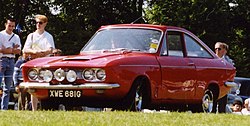| Bond Equipe | |
|---|---|
 Bond Equipe 2-Litre Saloon | |
| Overview | |
| Manufacturer | Bond Cars Ltd |
| Production | 1963-1970 4,389 made [1] |
| Assembly | United Kingdom: Preston, England |
| Body and chassis | |
| Class | Sports car (S) |
| Body style | 2-door saloon 2-door convertible |
| Powertrain | |
| Engine | Triumph 1147, 1296 or 1998 cc |
| Transmission | 4-speed manual optional overdrive on 2 litre |
| Dimensions | |
| Wheelbase | 93 in (2,362 mm) [2] |
| Length | 160 in (4,064 mm) [2] |
| Width | 60 in (1,524 mm) [2] |
The Bond Equipe is an English 2+2 sports car, manufactured by Bond Cars Ltd from 1963 to 1970. It was the first 4-wheeled vehicle from Bond Cars.



